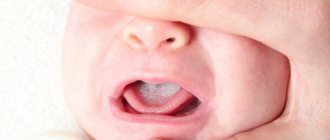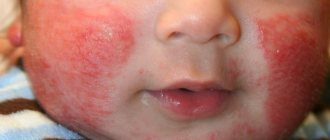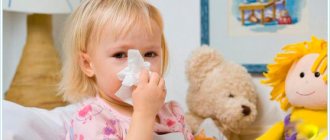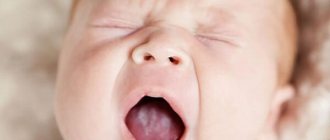( 1 ratings, average: 5.00 out of 5)
Home » Fungal diseases
Thrush in the mouth of a baby is quite common. The disease is caused by a fungal infection of the genus Candida. It is characterized by the appearance of a whitish or yellow coating on the entire surface of the oral cavity and unpleasant sensations.
What does thrush look like in a baby's mouth?
Often mothers notice that white spots have appeared on the child’s tongue.
Thrush in a baby's mouth is a common occurrence. It is characterized by obvious symptoms - a whitish coating on the mucous membranes. Candidiasis is easy to treat. When the first signs appear, you need to show the baby to the doctor, the doctor will assess the condition and prescribe treatment.
Why does it appear
Candidiasis occurs in people of different ages: adults and infants. The main difference is in the affected areas. In adults, the genitals are primarily affected, and in children, the tongue, gums, and palate are affected.
The main reasons influencing the development of the disease are the following:
- poor hygiene is possible both during breastfeeding and artificial feeding. In the first case, mothers do not wash their breasts and nipples well before feeding. And in the second, the nipples and bottles do not boil well enough. As a result, thrush may appear in newborns;
- if the mother began to introduce early complementary foods, then candidiasis may occur. Fungi multiply especially well in a sweet environment - sweetened water and other sweets contribute to thrush;
- After antibiotics, people of any age experience a sharp increase in Candida fungi. If the baby has had an illness and took antimicrobial drugs, then there is a high probability of developing pathology;
- infection also occurs during childbirth. The baby becomes infected when passing through the birth canal;
- increased air dryness in the room where the newborn lives;
- infectious diseases, dysbacteriosis, teething and other problems that weaken the immune system can also cause thrush.
Doctors identify a number of additional factors that contribute to the development of the disease.
Among them: frequent regurgitation (residues of milk contribute to the development of candida), small cracks in the mouth area, immature mucous membrane. According to statistics, premature babies are more likely to suffer from pathology than those born at term.
Clinical picture
Many young parents wonder what thrush looks like in babies. Sometimes it is confused with milk residues.
To accurately determine whether your baby has candidiasis or remains of milk, you need to try to scrape off the plaque. The milk will easily come away from the tongue, the cheesy plaque will come off with difficulty, and in its place there will be a red, inflamed spot.
- A white coating appears on the mucous membranes of the oral cavity (tongue, gums, inner cheeks, palate). Soon it turns into curdled plaques or specks.
- There is inflammation of the mucous membrane itself, it turns red. Gradually the number of spots increases (if no measures are taken to treat candidiasis).
- As the disease progresses, the baby becomes capricious. He refuses milk because sucking is painful.
In the photo you can see what candidiasis plaques look like. But don't rush into diagnosis. Only the pediatrician deals with her.
Forms of the disease
There are three degrees of the disease. Each has its own characteristics.
- With mild thrush in children, rare white spots in the mouth and redness of the mucous membranes are observed.
- Moderate degree is characterized by heavy plaque in the mouth. Under the plaques there are bleeding wounds.
- Severe disease is characterized by severe swelling of the oral cavity. All shells are covered with a thick cheesy coating. Possible increase in body temperature. After using antiseptics, thrush does not go away. Stronger medications are required.
Doctors also distinguish acute and chronic forms of candidiasis. The first one goes away with clear symptoms; with treatment, the baby quickly recovers.
The second case is characterized by a sluggish and constant course of the disease; long-term and complex therapy is required.
Symptoms of thrush in children
Thrush in children of the first year of life begins with dryness and redness of the oral mucosa, against which a plaque forms in the form of white or yellowish dots, reminiscent of semolina. As the colonies grow, they merge and form whitish, curd-like films that rise above the mucous membrane.
In mild cases of the disease, the plaque is easily removed, revealing a juicy, bright, hyperemic, slightly swollen surface underneath (see Figure 1).
Figure 1 - What oral candidiasis looks like in a newborn. Illustration source: Medscape.com
The moderate course of thrush is characterized by the spread of infection to the mucous membrane of the cheeks, tongue, hard palate, and lips. The curdled layers become denser, merge, and are not completely scraped off. When they are removed, the bleeding surface is exposed. In severe cases, large areas of the oral cavity, tonsils, posterior surface of the oropharynx, and esophagus are affected.
The plaque is impregnated with fibrin and takes the form of thick gray-white films, tightly fused to the mucous membrane, which are difficult to peel off with the formation of erosions and ulcers of the mucous membrane. With a common process, the baby's sucking and swallowing are impaired.
The atrophic form of the disease is characterized by the absence of a white coating: the affected mucosa is dry, fiery red, swollen, and sharply painful.
3.1. Candidal gingivitis
Candidal gingivitis is a fungal infection of the gum mucosa, which manifests itself as swollen pale pink gums with numerous ulcers. The sores have an uneven bottom covered with a gray coating.
3.2. Candidal glossitis
Candidal glossitis is characterized by the presence of a whitish coating on the entire surface of the tongue, with the exception of the lateral surfaces and tip, which over time becomes yellow-gray and dense. The mucous surface of the tongue becomes dry, hyperemic, smooth, thinned, devoid of papillae, and painful.
3.3. Seizures
Cheilitis is a lesion of the entire surface of the lips or its angular part (candidiasis), which manifests itself in the form of cracks in the red border of the lips and corners of the mouth. The cracks bleed and scales form on them. In the corners of the mouth, the seizures are dense, infiltrated, and painful.
3.4. Tonsillomycosis
Tonsillomycosis is a fungal infection of the tonsils. Its main manifestations are sore throat, dry mouth, and dry cough. Limited bright red spots, covered with a milky-white coating, form on the surface of the tonsils. Small lesions merge and form an extensive dense film, difficult to remove with a spatula.
Plaque can also be visualized on the tongue, palatine arches, inner surface of the cheeks and lips. Regional lymph nodes are enlarged. The disease is cyclical in nature (repeats after 2-3 weeks) and does not respond well to traditional treatment.
3.5. Pharyngomycosis
Pharyngomycosis is a mycotic lesion of the posterior pharyngeal wall. Patients are concerned about sore throat, sore throat, sensation of a foreign body in the throat, dry cough.
Upon examination, you can reveal bright hyperemia of the mucous membrane of the pharynx, a cheesy coating that can be easily removed with a cotton swab. After removing the film, a bright red mucous membrane, less often an erosive surface, is exposed. Pharyngomycosis is often accompanied by the formation of candidiasis in the corners of the mouth. The posterior cervical lymph nodes are enlarged.
Treatment
Young parents do not always know how to cure thrush in a newborn or how to treat it at home. Candidiasis is easily treated, but it is necessary to carry out therapy until complete recovery. Otherwise, the baby will temporarily feel better, and then cheesy plaques will appear on the tongue again.
Doctors, including Dr. Komarovsky, in addition to drug treatment, recommend adjusting the diet of nursing mothers. It is necessary to remove sweets, smoked, canned and pickled foods from the diet, and exclude potential allergens (citrus fruits, red fruits).
Additionally, all things that the baby has taken or is putting in his mouth are disinfected - pacifiers, toys, teethers. All items are treated with a soda solution (4 teaspoons per half liter of water).
Drug treatment
Drug therapy involves treating the tongue and oral cavity with antifungal solutions.
Most often, doctors prescribe the following drugs:
- Nystatin is an inexpensive drug against fungus. The tablet is diluted in water and problem areas are treated with this solution several times a day;
- Candide is a clotrimazole-based product, used only as prescribed by a doctor. Use 2 to 4 times a day;
- Miramistin is a liquid solution, odorless and tasteless. Aggressively affects fungi and other microorganisms. The number of injections of the drug is determined by the doctor. Treatment lasts about 5 days;
- If a baby is diagnosed with moderate thrush and is older than 6 months, then Fluconazole, Mikosist, and Diflucan are prescribed for general therapy. The dosage is determined by the pediatrician.
Soda solution
The disease can also be cured using folk remedies. When the first symptoms appear, it is advisable to use soda. The powder solution destroys Candida fungi.
- Prepare a glass of warm water, first boil it. Add a teaspoon of baking soda and dissolve the powder.
- Take a sterile bandage or gauze and wrap it around your finger (hands should be clean). Dip your finger in the soda solution.
- Gently treat the child's tongue, cheeks, and palate. You just need to blot the mucous membrane without removing the white coating.
- Treatment with soda is repeated four to five times a day. Soon the number of plaques will decrease significantly.
If the baby does not want to open his mouth, then gently press his chin with your finger. Hold it until you treat the mucous membrane.
Other folk recipes
- A honey solution will help cope with candidiasis. Honey is a good natural antiseptic; it will help neutralize the development of fungi. Mix 1 part honey and 5 parts boiled water, heat the mixture in a water bath. Then the baby’s oral cavity is treated with this solution. But you can use the recipe if the child is not allergic to honey.
- Prepare a decoction of medicinal herbs - mix a teaspoon of chamomile and calendula (take a dried plant), pour a glass of boiling water. Leave for several hours. Use this product to lubricate plaques in your baby's mouth.
- Mix aloe juice and raspberry juice in a 1:1 ratio. Dilute half and half with boiled water. Treat your baby's mouth. This method is suitable for older children. Make sure that a raspberry seed does not get into your baby's mouth to prevent him from choking.
Plaque on the genitals
Most often it affects girls. If a child has a white coating on his genitals, then we are talking about vaginal candidiasis or vulvitis.
The labia and vaginal mucous membranes are covered with a white, cheesy film. Possible itching, burning, pain when urinating. When the first symptoms appear, you need to contact a pediatric gynecologist and undergo the prescribed treatment.
Diagnostics
If you notice the first signs of thrush, it is recommended to immediately contact your pediatrician or pediatric dentist and undergo the following diagnostic examinations:
- Give a mouth swab . A small amount of plaque from the oral cavity is applied to a special glass and dried. Next, the doctor uses a microscope to perform an examination and establish an accurate diagnosis.
- General blood analysis. It will help determine the degree of intoxication in the body.
- General urine analysis . Submitted to determine glucose levels.
- Do an immunogram . Comprehensive analysis to assess the state of the immune system.
In most cases, one oral swab is enough to detect candidiasis in a child.
How to avoid illness
Preventive measures will help minimize the risks of the disease. These include the following:
- always thoroughly boil feeding utensils (pacifiers and bottles); when breastfeeding, you need to wash your breasts (nipple and areola);
- after feeding, it is recommended to treat the nipples with a weak solution of baking soda;
- Expectant mothers should take care of their health during pregnancy. If doctors have diagnosed candida fungi, then it is necessary to be treated before birth, since the baby will become infected when passing through the birth canal;
- you need to control the cleanliness of the baby’s skin - bathe the baby daily, add chamomile decoction to the water;
- It is recommended to install a humidifier in the room and maintain the humidity at the set percentage.
If these measures are followed, children are much less likely to get candidiasis. Reviews from mothers indicate that children with strengthened immunity rarely encounter pathology.
Conclusion
Candidiasis in infants manifests itself in the form of plaque on the oral cavity, sometimes fungi develop in the genital area. This is an unpleasant disease that causes discomfort to the baby; children may refuse to breastfeed due to pain when sucking the breast.
Doctors warn! Shocking statistics - it has been established that more than 74% of skin diseases are a sign of parasite infection (Accarida, Giardia, Toxocara). Worms cause enormous harm to the body, and the first to suffer is our immune system, which should protect the body from various diseases. The head of the Institute of Parasitology shared the secret of how to quickly get rid of them and cleanse your skin, it turns out that’s enough. Read more .
Young parents often don’t know what to do when white spots appear. A doctor can easily diagnose thrush and prescribe treatment. Improvement occurs quickly, but for complete recovery it is necessary to continue therapy.
Recognizing and treating oral thrush in newborns
Just yesterday, your beloved baby was cheerful and lively, sucking milk with pleasure, playing, smiling.
And today he is capricious, refuses to take the breast or bottle, and cries. Look into the baby's mouth. Have you seen a strange whitish coating on your tongue? This is a sign of a fairly common disease in newborns - thrush. You shouldn’t be too afraid of this; with timely treatment, the plaque goes away quickly. We wrote earlier about white plaque on the tongue of a newborn (see article), this is a normal natural phenomenon, but if white “plaques” similar to cottage cheese appear in the mouth, then you need to react in time, and now we will show in detail how to identify thrush and tell you about ways to treat it.
What is thrush
From Wikipedia: Candidiasis (thrush) is a type of fungal infection caused by microscopic yeast-like fungi of the genus Candida (Candida albicans)
Symptoms of infantile thrush
The main symptom is that the child develops a white coating in the mouth. Spots or “plaques” appear on the mucous membranes of the mouth: on the tongue, palate, gums, and the inside of the cheeks, around which a slight inflammation often forms. When removing the plaque, redness will appear underneath (unlike the usual milky coating on the tongue).
The child may be restless, capricious, abandon the breast during feeding or refuse the breast (bottle) altogether, since sucking may cause him pain. After some time, small spots grow to form large light films or a curd-like coating.
Scrape off the white residue with a teaspoon. Did you manage to remove the curdled pieces? Are there red, inflamed spots left in their place? Your child has candidal stomatitis, or thrush.
Thrush is a fairly common disease that is caused by special fungi - candida. These fungi are present in every person without causing harm. However, when the baby’s immunity is weakened and the mother does not follow the rules of hygiene, the fungi begin to multiply quickly. As has already been written, a white coating similar to curdled milk appears in the newborn’s mouth, on the tongue, on the mucous membrane, on the surface of the cheeks (hence the name of the disease). But, unlike milk residues, it is quite difficult to remove with a napkin or cotton swab.
The main difference between thrush and traces of milk in the baby’s mouth is that milk residues themselves disappear some time after feeding. The white spots of thrush “spread” more and more throughout the baby’s mouth and tongue, causing pain.
(See photo: this is what thrush looks like in the mouth and tongue of newborn babies)
Causes
- Every person has the fungus Candida albicans, both adults and newborns. In babies, during teething (by the way, here are the main problems that can arise during teething), with a cold or dysbacteriosis, the immune system weakens, conditions for the active growth of fungus appear (you may be interested in reading about ways to support the immune system in children under one year old) ;
- If the mother does not comply with hygiene standards (keeping the mammary glands clean, boiling bottles and nipples, as well as the child’s toys), the prerequisites for the development of the disease are created;
- Candida fungi love sweets, so sweetened water or a mixture contributes to their rapid reproduction;
- If the child’s mother is sick with thrush, there is a high risk of the baby becoming infected;
- Taking antibiotics can also trigger the development of thrush.
If the disease appears, find out the cause of the infection so that after treatment the baby does not become infected with thrush again.
What is the danger of the disease
When a child gets thrush, a greasy, rough coating appears in the child’s mouth, under which inflamed spots are found. If the lesion is severe, the spots may even bleed. There is a high probability of a more serious infection entering the baby’s body through them.
When thrush is advanced, plaque spots form a dense film that covers the entire oral cavity and spreads to the inner surface of the baby’s throat. The gums and lips become cracked and begin to bleed. Sucking and swallowing movements cause severe pain to the baby. The child is worried, screams, refuses to take the breast or pacifier, and may develop a fever.
(see how plaque can spread)
this is a severe thrush in the mouth of a newborn baby
Causes of thrush
Immune protection in infants does not work the same as in adults. This increases the likelihood of pathogenic microorganisms penetrating through mucous membranes. Oral thrush develops when Candida fungi colonize and multiply. During their life, they form a white coating on the mucous membrane, which is used to diagnose the disease.
The causes of candidiasis in infants are as follows:
- Violation of hygiene standards. Seeing an unfamiliar object or a favorite toy, the child pulls it into his mouth. This provokes the entry of bacteria and pathogenic fungi into the body. Due to low immunity, the body cannot cope with infection.
- Early introduction of complementary foods. The main danger is sweeteners, since sugar is a breeding ground for fungus.
- Frequent regurgitation creates an acidic environment, which is favorable for the spread of fungal cells.
- Forced use of potent drugs. Antibacterial agents have a special effect on the body. They provoke not only thrush, but also intestinal dysbiosis.
- Infectious and viral diseases. Children often suffer from ARVI, which affects the functioning of the immune system. This significantly increases the likelihood of thrush.
- Infection with thrush during childbirth. If a woman has not cured the disease before the birth of the child, then when moving through the birth canal he will become infected with candidiasis.
To avoid infecting your baby with fungi, it is recommended to thoroughly rinse the feeding bottle and nipple surfaces.
Main signs
Thrush in newborns can be chronic or acute.
It occurs in three stages, each of which is characterized by certain characteristics. At an early stage of development, the child becomes capricious. There are no pronounced symptoms of candidiasis; there is a thin layer of whitish plaque in the mouth. During this period, it is especially important to prevent the proliferation of fungi, so you should know what the manifestation of the disease looks like.
As the fungi multiply, plaque spreads to the lips. Inflammations and small ulcers form underneath, causing pain. At this stage, a sour odor appears from the mouth. Appetite decreases and apathy appears.
In the last stage, symptoms progress. Fungi colonize the surface of the nasopharynx and respiratory tract. It becomes difficult to remove plaque from the oral cavity. If measures are not taken in time, candidiasis forms in the intestines and genitals. This leads to the child refusing to eat and a significant deterioration in well-being.
The following symptoms appear:
- increased body temperature;
- weight loss;
- pimples on the tongue;
- nausea and vomiting.
How to treat thrush
If you find cheesy plaque spots in your baby’s mouth, don’t panic. Thrush in newborns is highly treatable. The main thing is to regularly carry out the necessary procedures until complete recovery.
It is necessary to show the sick child to a pediatric therapist. Depending on the degree of development of the disease, he will prescribe treatment. nystatin- based medications .
But sometimes it is not possible to visit a doctor right away. After all, a child can get sick on weekends when clinics are closed. It is permissible to begin treatment and alleviate the baby’s condition on your own.
Treatment with soda
- To treat the baby's oral cavity, you will need a soda solution. Pour 1 tsp into a glass of warm boiled water. baking soda, dissolve well.
- Prepare a napkin from a wide bandage or gauze, wrap it around your finger, soak it in the solution and carefully wipe the inside of the newborn’s mouth and tongue. Just wipe or moisten without trying to remove the white coating. After all, hidden underneath are inflamed spots - plaques, sometimes even bleeding. You should not allow pathogenic microbes to enter the child’s body through them.
- Do these procedures 4-5 times a day every 2-3 hours for several days. If the baby does not open his mouth on his own, press the chin with your thumb and hold it there until you finish moistening.
Newborn therapy
After birth, babies develop candidiasis, as they tend to burp frequently. Every mother should try to improve her feeding technique as much as possible.
At an appointment with a pediatrician, you can learn how to remove thrush from a newborn. There are two main ways to do this:
Soda. Add 1 teaspoon of soda to a glass of warm water. Wipe the white areas on the tongue with a prepared soda solution every 2 hours.
Manganese. Wipe the affected areas in the child’s mouth with the medicinal solution.
It is possible to cure candidiasis in a six-month-old child in the same way as in a baby. The only difference is in the medications: Nystatin, Miramistin and Candide.
Candidiasis in a child’s mouth: causes, symptoms, treatment
In childhood, a disease such as thrush often manifests itself in the oral cavity. According to statistics, almost 25% of young children experience this disease several times. The mild form is asymptomatic. With the development of candidiasis, sharp unpleasant sensations appear in the oral cavity.
The problem rarely disappears on its own, so a competent approach to treatment is required. Thrush can be prevented with simple preventative measures.
Candidiasis or thrush - what is it?
Fungal stomatitis is an inflammation of the oral mucosa, with the formation of a specific plaque. The pathology is caused by the microorganisms candida albicans or candida tropicalis. These are the most common fungi found in the oral cavity of children and adults with thrush. Like other bacteria, candida is present in the human body without causing harm.
Candida Albicans
Under unfavorable factors, candida begins to actively develop, affecting the mucous membranes, including the oral cavity. This is largely facilitated by a decrease in the immunological status of the child’s body. A massive amount of pathogen enters from the outside. The deficiency of beneficial bacteria does not allow the fight against fungi, and thrush begins to develop actively.
The child’s immune system is not yet formed and is poorly adapted to infections. For this reason, the disease is more common in children. Favorable conditions for infection are created through contact with contaminated toys when the baby puts them in his mouth.
The causative agent of infection
Thrush in a child is caused by a whole group of yeast-like fungi: Candida krusei, Candida albicans, Candida tropicalis, etc. They live not only in the environment, but also in the mouth and intestines. The presence of a strong immune system serves as a barrier to the proliferation of bacteria, so a healthy person does not have thrush. And, in the presence of favorable conditions in the body (increased pH of the mucous membrane, decreased immunity, the presence of concomitant diseases: diabetes mellitus, endocrine disorders), bacteria begin to actively multiply, causing candidiasis.
Candidiasis can easily be contracted from another person through direct contact with the skin or mucous membrane of a patient. If the bacterium finds itself in conditions unfavorable for life, it is covered with a double protective shell and temporarily “falls asleep” waiting for the right moment (for example, when the body’s defenses weaken).
Causes of thrush in a child's mouth
Fungal infections are often observed in premature babies, since they usually have weakened immunity. Formula-fed infants are also susceptible to candidiasis.
Mother's milk contains specific substances that prevent candida from developing in the baby's mouth.
Other reasons are:
- infection from the mother through the birth canal;
- the fungus is localized on the nipples of the mammary glands; when breastfeeding, there is direct contact between the oral mucosa and the fungal flora;
- poorly processed feeding bottle;
- contamination of pacifiers by fungi;
- poor adult hand hygiene when caring for animals, as a result, candida gets to the child;
- long-term treatment with antibiotics;
- Frequent regurgitation by the baby during feeding.
Human saliva has protective properties against many microbes. Oral candidiasis often occurs against the background of increased dryness of the oral mucosa. Older children get thrush from consuming contaminated fruits, vegetables, raw milk and water. If meat is contaminated with a fungus and is located next to other products, then the risk of transmitting the infection will be very high.
Attention! Oral candidiasis in children over 1 year of age. Requires close attention from parents. The sudden appearance of the disease may indicate the presence of other serious pathologies in the body.
Fungal stomatitis in the mouth of children is formed against the background of any factors leading to a decrease in protective properties. These are lack of sleep, vitamin deficiencies, chronic and acute psychological trauma, and poor nutrition.
How does thrush on a child’s lips manifest and be treated?
Thrush on the lips of a child occurs due to an imbalance of microorganisms in the oral mucosa. The catalyst for the pathological condition is the Candida fungus. In normal health, it lives safely in the gastrointestinal tract. However, under certain favorable circumstances, the fungus becomes more active, provoking the development of the disease.
The essence of pathology
Thrush is often diagnosed in children under one year of age. A similar diagnosis is made in 20-30% of infants.
This phenomenon can be explained by the fact that the child does not have his own immune system during the first year of life. The child's body is defenseless against various diseases, including candidiasis.
Breast milk helps increase a child's resistance to diseases. Formula-fed children are deprived of such protection.
Infection of a child with candidiasis can occur during childbirth. If a woman has vaginal candidiasis, the baby will inevitably become infected. The fungus can penetrate into the child’s mouth, nose, eyes and ears.
Another possible version of events could be infection of the fetus during pregnancy. If the expectant mother does not treat the disease in a timely manner, or the therapy is not effective in case of extensive damage, candidiasis can also affect the child.
Reasons for the development of the disease
Candidiasis in children is one of the most common pathological conditions. According to statistics, more than 70% of adults who are carriers of a fungal infection transmit it to children in a variety of ways:
- in contact with adults during kissing, changing clothes or feeding;
- during the treatment of the umbilical wound;
- in case of non-compliance with hygiene standards by the mother during breastfeeding with candidiasis in acute or chronic form;
- during labor;
- in case of sharing personal hygiene products.
When the fungus enters the child’s body, it becomes active, beginning to actively multiply, while building colonies and filaments of mycelium.
Provided that treatment is carried out in a timely manner, the fungus will die, leaving behind antibodies. Fungi are very active in a nutrient medium that contains sugar.
It is for this reason that the inflammatory process in the area around the mouth develops in children who consume sweets or artificial mixtures.
Quite often it happens that when the fungus penetrates the body, thrush does not develop and does not make itself felt for a very long time. As a rule, the first signs of the disease appear on the child’s lips as a result of the influence of some negative internal factors, among which are:
- previous colds or flu;
- chronic pathologies of internal organs;
- the period of teething, when the child’s immunity weakens;
- in case of rickets or vitamin deficiency.
Another provoking factor that provokes the appearance of thrush on the lips of a child is the presence of active pathogenic microorganisms on the mother’s nipples. If the mother does not follow the rules of hygiene before and after feeding the baby, then the fungus may get into the baby’s oral mucosa and into small cracks or wounds on the lips.
Along with internal factors that provoke the appearance of thrush on the lips of a baby, experts also identify a number of external ones:
- prematurity of the baby;
- bathing a child with infected family members;
- baby’s toys, where candida fungi can settle;
- the use of formulas for artificial feeding containing sugar in large quantities;
- frequent regurgitation and constant dryness in the baby’s mouth.
Symptomatic manifestations
Candidiasis on the lips of a baby manifests itself as a white coating of a cheesy consistency on the gums, tongue and palate. If you try to remove plaque, you will find a red, inflamed area of the mucous membrane underneath it. This type of thrush is called candidal stomatitis, which has mild, moderate and severe forms.
In mild forms of thrush, the symptoms of the disease manifest themselves only as plaque on the oral mucosa. At the same time, the baby’s general well-being does not change. He, as before, remains active, his appetite does not disappear. A mild form of thrush responds very well to treatment, and if the doctor’s instructions are followed, the disease goes away within a week.
If it comes to moderate severity of the disease, then it is characterized by a slight rise in temperature, the baby becomes restless, and his appetite decreases.
When the white plaque is removed, bleeding appears on the oral mucosa.
Therapy for this form of the disease should be carried out comprehensively: it is necessary to treat the oral cavity with antifungal drugs, in which the disease goes away within 2 weeks.
If a baby has developed a severe form of thrush, then the body temperature rises to 38ºC, he constantly cries and refuses to eat. In this case, the white plaque in the oral cavity resembles a film and covers the entire mucous membrane and throat. Under the current circumstances, complex treatment will last more than 3 weeks.
Sometimes thrush in infants also affects the skin, especially in those parts of the body where diaper rash forms in the skin folds. This type of disease is called candidal dermatitis. It is localized in the cervical region, in the area of the inguinal folds, and can also spread to the skin of the buttocks, back, arms and legs.
In this case, the active proliferation of fungi is provoked by the warm and humid environment that forms under diapers and thick diapers.
The delicate skin of a baby is very susceptible to fungal infection, so you can see the formation of huge red spots on it that have a shiny surface and cause pain and discomfort to the baby. It happens that candidal rashes resemble small pimples with a white cap.
If thrush develops in a baby older than one year, this is evidence of a weakened immune system. As in infants, in these children the disease manifests itself in the mouth. But if a child has developed the habit of putting his fingers in his mouth, then the fungus can affect the skin around the nail.
Principles of treatment
Treatment of candidal stomatitis in children under any circumstances should be prescribed only by a pediatrician.
As a rule, to treat thrush on the lips and in the oral cavity, the doctor prescribes treatment with a 2% soda solution in those areas where white plaque appears. Wiping should be done with sterile gauze wrapped around a finger and soaked in a solution.
The treatment will be very effective if you use the vitamin medicine Biovital-gel. In any case, you should not self-medicate.
According to a doctor's indication, Nystatin in drops, Diflucan and Candide in the form of tablets or solution can be used in the treatment of the disease.
Treatment should be continued until there is a noticeable improvement in the little patient’s condition. Doctors recommend that the mother also undergo examination. This is necessary in order to identify a fungal infection in a woman.
If present, treatment must be carried out to prevent re-infection of the baby.
If the child has developed a severe form, or the treatment turned out to be ineffective, then the child must be treated in a hospital. Intravenous administration of drugs is necessary to obtain the maximum effect from their use.
Possible complications after the disease include the fact that thrush can also affect other organs. Female infants may develop vaginal candidiasis. This is a very dangerous condition, as fusion of the labia or vagina can occur.
The problem can only be solved surgically.
Against the background of candidiasis, a child may develop sepsis, which will lead to a fungal infection entering the blood and spreading throughout the child’s body.
With inadequate or incomplete treatment, candidal stomatitis can lead to consequences such as disturbances in appetite, daily routine and sleep, deterioration of the immune system, the development of an allergic reaction and the emergence of a predisposition to other pathologies, for example, bronchial asthma.
Of great importance in the treatment of candidal stomatitis is the care of the skin and mucous membrane of the oral cavity. An important role is played by taking various antibacterial drugs prescribed exclusively by a pediatrician, and timely treatment of all existing diseases in the baby.
Thrush in children has a lot of unpleasant consequences, so a woman needs to monitor her health already at the stage of planning pregnancy and exclude the disease, as well as take the necessary preventive measures to prevent its occurrence in order to protect the baby from infection with candidiasis.
Source: https://stopmol.ru/molochnitsa/molochnitsa-na-gubah-u-rebenka/
Symptoms of oral candidiasis
- At the onset of the disease, hyperemia and slight swelling appear in the child’s mouth on the gums, soft and hard palate, and tongue. The newborn becomes capricious and refuses food and pacifiers.
- Then whitish spots form on the reddened areas, which merge into a single focus similar in structure to a curd mass. The mouth gradually becomes covered with plaque. Its color ranges from muted white to yellowish.
Candidiasis in a child’s mouth is accompanied by burning and painful swallowing. Hot, spicy or sour foods cause particular discomfort. Frequent regurgitation is observed during breastfeeding. Lack of nutrients leads to developmental delays.
When the fungus is localized in the corners of the mouth, cracks covered with plaque form. The affected area is hyperemic and may bleed.
Attention! With thrush in children, there is a sharp increase in body temperature for no reason, so it is necessary to monitor hyperthermia in infants, even at night.
Depending on the course, there are three types of candidiasis:
- Light form. The oral mucosa becomes covered with a reddish rash, which is masked by a white coating. After treatment with antiseptic solutions, thrush recedes.
- Moderate form. White spots appear on hyperemic and swollen areas affected by soft tissue candidiasis. Gradually they merge and become covered with plaque, which, when removed, exposes the bleeding surface.
- Severe form. Thrush is found on the child’s lips, tongue, gums and even throat. The entire mucous membrane is covered with a continuous white film. The condition worsens sharply, hyperthermia is accompanied by dehydration against the background of severe candidiasis.
Prevention of lip candidiasis in children
Prevention is always easier than cure. Moreover, preventive measures in this case are aimed at generally strengthening the baby’s defenses and protecting him from harmful external factors.
- Hygiene. This is the very first and most important rule. Observance of all necessary measures by parents when contacting their child.
- Handling the child’s personal belongings – bottles, nipples, cups, spoons. Also keeping clothes perfectly clean and ironing, especially for newborns.
- Treating toys with disinfectant solutions. It is not recommended to buy soft toys for small children or those that cannot be subjected to heat treatment or washed in special antiseptic solutions.
- General strengthening procedures - hardening, walks in the fresh air (preferably in any weather, but without fanaticism), clothing according to the season.
And most importantly - rational and high-quality nutrition. If this is breast milk, then the mother must carefully monitor her diet, make it varied, safe and healthy not only for herself, but also for the baby.
Treatment of oral candidiasis in a child
First of all, with thrush it is necessary to prevent the spread of infection. Patients are isolated and contact children are examined. Initial measures are aimed at eliminating severe symptoms. Next, they begin to localize the growth of fungi in the mouth and throughout the body.
Treatment of thrush in newborns and infants
Oral thrush in infants is not uncommon. If the disease is mild, no special treatment is required. There are enough measures to reduce symptomatic phenomena. Treating your mouth with a light antiseptic will help eliminate discomfort in 1 day.
Parents need to remember that the temperature in the room where the child is located should not exceed 20 degrees, and the humidity should not exceed 50%. If the air is excessively warm and damp, this promotes the development of many fungal spores, including candida. Ventilating the room frequently will help maintain optimal conditions.
Excessively dry air will also affect the condition of the oral mucosa. For a child, it will dry out, leading to the appearance of microcracks. In these damaged areas, the fungus begins to actively develop, leading to the full development of candidiasis.
If thrush appears on the lips of children, then they are already talking about an advanced form. In this case, it is necessary to carry out full treatment.
The baby's oral mucosa is systematically wiped with a solution of baking soda. One teaspoon per liter of water is enough to obtain a medicinal solution. Sterile cotton swabs are moistened in this mixture and gently wiped over the child’s entire mouth. Treatment is carried out up to 6 times a day.
If candidiasis develops in children older than 6 months, then the following drugs are allowed:
The method of application and dosage is calculated by the pediatrician at the appointment.
Children from one to 3 years old
Treatment of oral candidiasis in children 3 years of age is carried out comprehensively, affecting the problem locally and generally.
- If the child is able to rinse the mouth correctly, then a solution consisting of one Nystatin tablet, one ampoule of vitamin B12 and 10 ml of saline solution is suitable for treating the mucous membrane.
- If there is severe itching on the lips, gums and skin around the mouth, use Fenistil gel. The product has an antihistamine effect and reduces the irritability of pathogenic microflora. Parents need to ensure that the gel does not accidentally get into the baby’s mouth.
- The simplest way to act as an antiseptic is to rinse with a solution of baking soda. The product has a pronounced fungistatic effect. It allows not only to stop the development of fungal flora, but also to reduce pathogen colonies in the oral cavity.
- The affected areas are generously lubricated with Nystatin ointment or Lugol's solution.
- To strengthen the immune system, B vitamins, calcium, and iron supplements are indicated.
- Closer to 3 years and older, the oral cavity can be treated with antiseptic sprays, such as Maxicold ENT or Hexoral.
If thrush has developed while taking antibiotics, they should be discontinued. Medicines are replaced with other drugs after consultation with the doctor. The withdrawal of antibacterial drugs is carried out slowly so as not to provoke an exacerbation of the general disease for the treatment for which they were prescribed.
An important point in treatment is eliminating the cause. It is necessary to sterilize feeding bottles, dishes, pacifiers, and clean toys with an antiseptic.
If the baby is still breastfed, then the mother needs to thoroughly wash her breasts with soapy water. Then treat with an antiseptic solution. Use, for example, Miramistin.
Treatment of candidiasis in older children
In infants, thrush is cured quickly. At older ages, systemic therapy is required. It is better to use drugs based on fluconazole. The active substance has an antifungal effect on the entire body at once. Frequently prescribed representatives are: Diflazon and Diflucan. The drugs are administered intravenously, intramuscularly or orally.
Locally affected areas are treated with antiseptics, for example, 0.1% chlorhexidine. A 1% solution of brilliant green or methylene blue will do. Under their influence, the fungus stops actively reproducing. From the general impact shown:
- vitamin therapy;
- good nutrition;
- physical education;
- hardening;
- Spa treatment;
- summer holiday at sea.
Older children suffer from thrush a little longer than babies. During this period, fungal flora can affect not only the oral mucosa, but also spread throughout the body.
Drug treatment
Treatment of thrush on the lips in children includes methods that would help stop the proliferation of the fungus, alleviate the symptoms of the disease, and also stop the causes of its development. Most often, thrush occurs without any complications, so it does not require therapy. Here we need methods that can overcome unpleasant symptoms.
An advanced form of thrush is treated with topical medications. To do this, use the following means:
- Nystatin. This drug is available in tablet form. But they should not be taken internally. Simply take 1 capsule, grind it, and then combine it with warm water. Wipe the affected areas of the mouth and lips with the resulting composition 6 times throughout the day.
- Candide. This solution contains the active ingredient - clotrimazole. Treat the oral cavity 2-4 times a day.
- Miramistin. This is a solution that has a wide-spectrum antibacterial effect. Can be used to treat the mouth and lips of a newborn. It is necessary to wipe the affected areas with gauze wrapped around a finger and soaked in the solution. Carry out manipulations 3 times a day.
Infants from 6 months can be prescribed the following medications:
The dosage and duration of the course are determined individually for each patient. This takes into account his age and weight. Children from 1 year old can use soda rinses, Lugol's solution, Nystatin ointment or Miramistin ointment.
If the child can rinse his mouth, then prepare a solution for him, dissolve a Nystatit tablet in 10 ml of saline solution. Add an ampoule of vitamin B12 to the resulting composition. Rinse 3-4 times throughout the day.
If the skin around the mouth and lips are very itchy, then Fenistil gel is used. Just lubricate the affected areas with it. But do this carefully so that the medication does not come into contact with your eyes and mouth. Children over 3 years old can treat the oral cavity with Hexoral and Maxicold Lor sprays.
As you know, children do not like to take pills, so a product such as Decamine was released. This drug is available in the form of lozenges. The baby will willingly suck them, believing that this is an ordinary candy. But the drug will destroy all fungi in the mouth. Take 1 tablet every 2-3 hours.
If thrush on the lips is severe, the doctor will prescribe stronger medications, including:
As soon as the child has eaten, he needs to be given some boiled water. This will allow you to control the acidity of the oral cavity, because fungus multiplies in an acidic environment.
Traditional methods
Treatment of mild candidiasis is allowed with folk remedies. They will reduce itching and swelling of the oral mucosa. From alternative medicine, the following medicinal herbs have proven themselves:
To prepare the required solution, brew 1 spoon of herb with a glass of boiling water and leave for 30 minutes. The resulting decoction should be used to rinse your mouth frequently throughout the day, after meals.
Attention! Self-treatment of thrush is unacceptable. Inappropriate selection of medications will lead to the formation of advanced candidiasis and severe complications.
If thrush appears on the baby’s gums, tongue and palate, then wipe the affected areas with a gauze cloth soaked in decoctions of medicinal plants.
In adult children, the mouth is treated with aloe juice. The natural remedy has a pronounced regenerating and anti-inflammatory effect. Rinse your mouth with partially diluted aloe juice for 5–7 days until the plaque begins to decrease.
Thrush on the lips of a baby - symptoms, diagnosis, treatment
Thrush on the lips of a baby is a fairly common problem that parents face. Candidiasis is the scientific name for this infection.
A white, cheesy coating on the baby’s tongue and palate is the first symptom of an unpleasant disease. Unfortunately, it is either not noticed at all or not given much importance.
And in vain, because as the pathology develops it can bring a lot of trouble to both the baby and his parents.
- Causes
- Symptoms
- Photo
- Diagnostics
- Treatment
- on the topic
Diet
Compliance with the diet is recommended for many diseases. In case of candidiasis, the following foods should be avoided:
- sweets;
- sour foods;
- black tea and coffee;
- mushrooms;
- dairy products;
- products using yeast dough;
- carbonated drinks;
- salty, sour and spicy foods.
Semi-liquid porridge is suitable for children. Fish and meat should not be fatty and well-cooked. It is allowed to take boiled chicken eggs, baked apples, and boiled potatoes. Infants should be given warm water or chamomile tea frequently.
https://youtu.be/B-KkW_S1vMw











